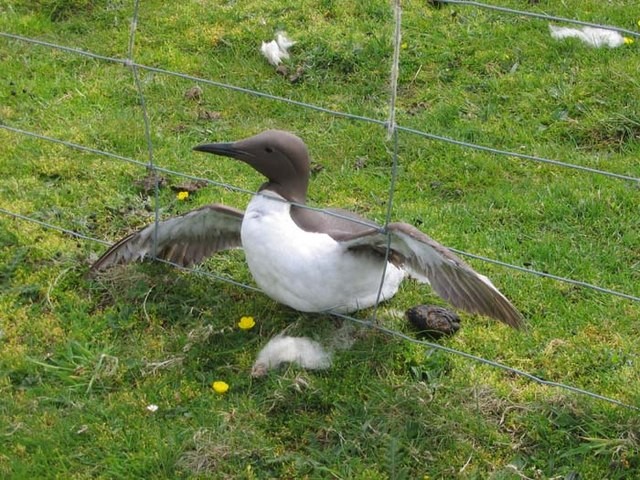Common Murre
A species of Murres, Also known as Thin-billed Murre Scientific name : Uria aalge Genus : Murres
Common Murre, A species of Murres
Also known as:
Thin-billed Murre
Botanical name: Uria aalge
Genus: Murres
Content
Description People often ask General Info
 Photo By Dumgoyach , used under CC-BY-SA-2.0 /Cropped and compressed from original
Photo By Dumgoyach , used under CC-BY-SA-2.0 /Cropped and compressed from original Description
The common murre is 38–46 cm (15–18 in) in length with a 61–73 cm (24–29 in) wingspan. Male and female are indistinguishable in the field and weight ranges between 945 g (2.083 lb) in the south of their range to 1,044 g (2.302 lb) in the north. A weight range of 775–1,250 g (1.709–2.756 lb) has been reported. In breeding plumage, the nominate subspecies (U. a. aalge) is black on the head, back and wings, and has white underparts. It has thin dark pointed bill and a small rounded dark tail. After the pre-basic moult, the face is white with a dark spur behind the eye. Birds of the subspecies U. a. albionis are dark brown rather than black, most obviously so in colonies in southern Britain. Legs are grey and the bill is dark grey. Occasionally, adults are seen with yellow/grey legs. In May 2008, an aberrant adult was photographed with a bright yellow bill. The plumage of first winter birds is the same as the adult basic plumage. However, the first pre-alternate moult occurs later in the year. The adult pre-alternate moult is December–February, (even starting as early as November in U. a. albionis). First year birds can be in basic plumage as late as May, and their alternate plumage can retain some white feathers around the throat. Some individuals in the North Atlantic, known as "bridled guillemots", have a white ring around the eye extending back as a white line. This is not a distinct subspecies, but a polymorphism that becomes more common the farther north the birds breed—perhaps character displacement with the northerly thick-billed murre, which has a white bill-stripe but no bridled morph. The white is highly contrasting especially in the latter species and would provide an easy means for an individual bird to recognize conspecifics in densely packed breeding colonies. The chicks are downy with blackish feathers on top and white below. By 12 days old, contour feathers are well developed in areas except for the head. At 15 days, facial feathers show the dark eyestripe against the white throat and cheek. 
Size
44 cm
Colors
Black
White
Life Expectancy
32 years
Nest Placement
Cliff
Clutch Size
1 egg
Incubation Period
1 brood
Number of Broods
26 - 39 days
Feeding Habits
Common Murre primarily consume small schooling fish like polar cod and capelin, crustaceans, squid, and occasionally molluscs and marine worms. They dive up to 591 feet, usually eating prey underwater. They forage alone or in flocks, potentially travelling over 100 km from breeding grounds if needed, but will stay local if food is abundant.
Habitat
Common Murre's habitat spans marine environments, notably at the interface of land and ocean. They breed on islands and steep rocky cliffs with cool climates and near deep waters that exceed 100 feet, which are rich in fish due to converging currents. Throughout the year, common Murre lives at sea, only approaching the shoreline during the non-breeding season without roosting on land.
Nest Behavior
Common Murre does not build traditional nests; egg-laying occurs once a year, typically on precipitous cliff faces. Both parents share incubation duties and chick rearing, ensuring the egg and offspring's survival.
Nest Characteristics
Common Murre lays its sole egg on a cliff ledge or similar locale, foregoing nest construction in favor of natural crevices or beneath boulders. Occasionally, adults may encircle the egg with pebbles, solidified by excrement to secure the egg.
Dite type
Piscivorous
People often ask
General Info
Feeding Habits
Bird food type
Behavior
Common Murre are primarily known for their strong pair bonds, often reflected in their elaborate courtship rituals, such as the 'water dance' and 'joy flight' displays. These birds exhibit daily activities that include foraging at sea for their diet of fish and invertebrates. They are social creatures nesting in dense colonies on coastal cliffs where they engage in synchronized behaviors, including sparring and preening during their greeting ceremony to reinforce pair bonds. Notable for their vertical nesting sites, common Murre have adapted to lay pear-shaped eggs to prevent them from rolling off the cliffs. They are also remarkable for their diving ability, plunging into the water to catch prey.
Distribution Area
The breeding habitat is islands, rocky shores, cliffs and sea stacks. Cape Meares, Oregon is home to one of the most populous colonies of nesting common murres on the North American continent. Some birds are permanent residents; northern birds migrate south to open waters near New England, southern California, Japan, Korea and the western Mediterranean. Common murres rest on the water in the winter and this may have consequences for their metabolism. In the black-legged kittiwake (which shares this winter habit) resting metabolism is 40% higher on water than it is in air. The population is large, perhaps 7.3 million breeding pairs or 18 million individuals. It had been stable, but in 2016 a massive die-off of the birds in the northeast Pacific was reported. The birds seem emaciated and starving; no etiology has been found. In general, potential threats include excessive hunting (legal in Newfoundland), pollution and oil spills. 
Species Status
Not globally threatened.